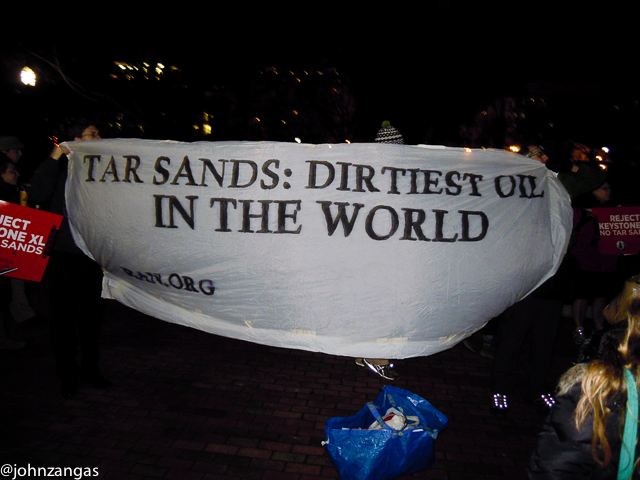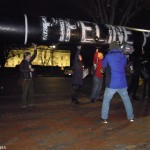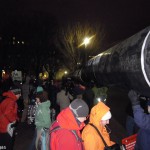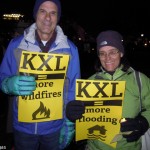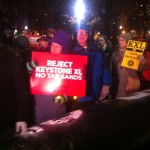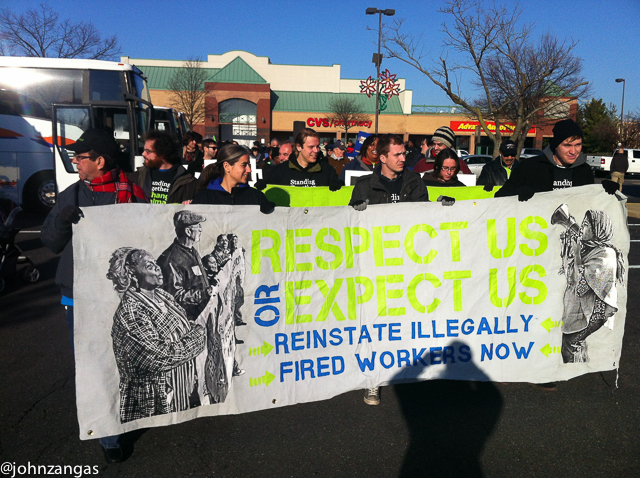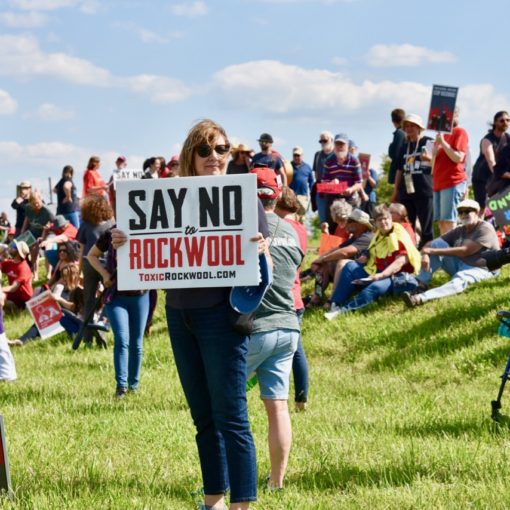by John Zangas
Environmentalists rallied at the White House Monday night with a giant faux pipeline, intensifying efforts to stop the Keystone XL pipeline just days after the State Department published its Final Environmental Impact Statement (FEIS). It was one of more than 280 actions coordinated across the country to stop the 2,000-mile pipeline from being built from Canada through five states to the Gulf.
While it acknowledged that the pipeline will contribute to emissions, the FEIS effectively gives President Obama the go-ahead to approve the permit for construction of it. The Keystone XL pipeline would transport liquefied tar sands from Alberta to Gulf Coast refineries to be exported. The State Department review is required because the pipeline crosses into U.S.territory from Canada.
But environmental groups remain optimistic that President Obama will not approve it because he does not want to go down in history with a climate disaster legacy.
“We are out here to let President Obama know that the people of this country are standing up to say no to the KXL pipeline and that we fully anticipate that he will reject it,” said Maura Cowley of Energy Action Coalition.
Cowley fired up the crowd in spite of the cold while other activists held a giant faux pipeline inflated with air. Behind her the Detroit Light Brigade held up illuminated letters spelling “NOKXL.”
Environmentalists have been warning about the local impacts the pipeline would have on the land and water. “These pipelines carry the type of oil that is particularly disastrous,” said G. Lee Aiken, Candidate At Large for DC Council. “This oil from the Canada tar sands is mixed into a toxic slurry of chemicals. It’s very abrasive with sand and very destructive to pipelines,” she said.
The largest inland oil spill in U.S. history occurred from a pipeline operated by Enbridge, carrying the same tar sands the Keystone XL will carry. The 840,000 gallon spill of diluted bitumen, known as “dilbit,” occurred in Tallmadge Creek, a tributary of the Kalamazoo River on July 25, 2010, resulting in a wipe-out of river life and flora. The fallout flowed downriver, damaging property and health of local residents. Aiken says this is a warning for future pipeline construction.
But central to environmentalist’s arguments against Keystone XL are the effects it would have on climate due to greenhouse gas carbon emissions. The SEIS analysis considered the emissions of the pipeline itself, not the emissions created from combustion of fuels it transports. “The tar sands are the dirtiest form of oil we have on the earth,” said Cowley. “The amount of tar sands that would be exported would be game over for the climate.”
The effect on global communities is but one of the concerns cited by environmentalists like Gene Karpinski, President of League of Conservation Voters. “We can’t have this pipeline as it significantly increases carbon pollution,” he said. “This is an important moment in the movement. You can’t fight climate change if you let that pipeline go through.”
Keystone XL would transport over 830,000 barrels per day of tar sands crude, heavily laden with carbon, creating a 6.7-7.6% increase in greenhouse gas emissions once it is combusted. While combustion would not take place in the U.S., the cumulative effect of mining and combusting tar sands, would increase average global temperature by 2 degrees Celsius, according to scientists, further propelling weather towards runaway cycles of climate change.
Scientists are virtually unanimous in linking global warming and climate change to due to the increased greenhouse gases from concentrations of carbon in the atmosphere. They have concluded that high concentrations of carbon in the Alberta tar sands will contribute to climate change.
Environmentalists have previously raised questions about the objectivity of the environmental impact itself. Environmental Resources Management (ERM), the firm which the State Department contracted to conduct the study, withheld that it had previously worked with TransCanada on the Alaska Pipeline Project, a joint project with Exxon-Mobile Corp.
Furthermore, a report by Mother Jones showed that the work history of experts was redacted to conceal that they had previously worked for TransCanada and other energy companies with an interest in the pipeline project. These consultants, the report said, had a stake in the favorable outlook for the pipeline’s impacts.
The State Department Inspector General is investigating whether ERM failed to disclose a conflict of interest it had with TransCanada for previous work it did with the construction firm.
Another issue against Keystone XL is job creation. While 3,900 jobs would be created during the construction phase, only 50 full-time jobs would continue after construction ends and Keystone XL is fully operational. Aiken says Keystone XL job creation is “a big lie.” “It’s not going to be a big job builder except for disastrous oil spills,” she said.
Support KXL Now writes on its website that construction of the Keystone XL pipeline “will support 42,000 high wage manufacturing and construction jobs in the United States, particularly in the states of Montana, South Dakota, Nebraska, Kansas, Oklahoma and Texas,” states through which the pipeline will run. But it does not state whether these jobs will continue after the pipeline is completed.
As part of the final process of the State Department FEIS, the public has been invited to participate in a 30-day period to comment on the pipeline. The comments will be open from February 5 until March 6 and will be included in the final report submitted to the President. Federal agencies, such as the Environmental Protection Agency, have a 90-day period to comment.
“It’s very clear that the next 90 days are going to matter, that we are going to have to take to the streets, write to our elected officials, and if we stand up, we can turn this thing around,” said Cowley.
John Kenney, Organizer with Chesapeake Climate Action Network said, “Everyone thought two years ago Keystone XL was a done deal, but it still hasn’t been built.” He also remains positive that the President will not approve it. “I’m pretty optimistic. There were quite a few people here on a cold night.”
But even if the President approves the final draft and permits the construction, the fight is not over. 350.org has organized a national effort to contact people who are interested in direct action to stop construction of the pipeline should it be built. In one Montana community, a renewable energy barn has been built in the path of the pipeline as a direct challenge.
“Over 70,000 people are signed up ready to take direct action to put their bodies on the line,” said Cowley. “This pipeline isn’t going to get built, one way or the other.”
Interview with G. Lee Aiken of DC’s Green Party:

